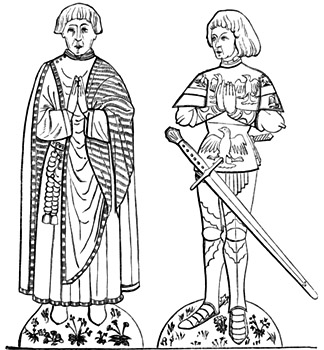
Drawing based on the monumental brass of
Alderman John Feld and his son John
from E. Cutts, Scenes and Characters of the Middle
Ages. London, 1925
John Feld senior must have been born around the beginning of the fifteenth century. The John Feld of Standon, Hertfordshire who died in 1408, and a John atte Feld brewer of London, whose will was made in 1405, are candidates for his father, and they may even be the same person. The alderman held property at Standon, as well as in Essex and Kent, and was residing in Standon by 1465.
He began his career as a stockfishmonger, and the unfinished inscription on his brass describes him as "a merchant of the staple of Calais"; in 1449 he was one of 15 commissioners appointed to negotiate with the Duke of Burgundy regarding the commercial interests of England and France, particularly the traffic in wool and woolfells through the Calais staple. But later in life he seems to have retired to his estates outside the city and in 1470 was described as "late of London, gentleman".
Feld served as sheriff of London in 1454, and two years later became an alderman, remaining such until 1463. In that year he obtained from the mayor a release from all future service to the city, on the grounds of illness. Yet the importance to him of aldermannic status is seen in that his brass depicts him wearing an alderman's gown atop his other clothes; the brass was originally inlaid with colour, traces of the red of the livery and the white of its fur lining still being visible at the time the above illustration was made. From his girdle hangs his purse, the mark of a man of business, and a rosary, to symbolize his piety.
His brass, in Standon church, states that John Feld senior died on 16 August 1474. His son and heir, John junior, was his executor, along with John junior's wife Agnes. This suggests a second son, indicated on the brass, had predeceased him – the risk of a father living to old age. John junior had the status of esquire and probably had chosen to pursue his career among the landed gentry. The contrast between the way he and his father are depicted on the brass is telling. John junior did not long outlive his father, dying in 1477; the brass indicates that he had two sons and two daughters.
The monument to the two Johns symbolizes one characteristic of the urban ruling class of the fifteenth century: that wealthy merchants were inclined to purchase extra-urban land – part investment, part acquisition of productive land to serve or expand their business, and part ambition to raise themselves into the ranks of the gentry. The transition in social status often took place across generations. It meant that the loyalties, interests, and preoccupations of urban leaders did not lay wholly with those they led, driving a wedge into the community, a concept important to the survival and advancement of towns in their early period of self-determination.
The divided loyalties are emblemized on the monumental slab on which the brass of the Felds was mounted. It was ornamented with the arms of the city of London, those of the merchants of the staple, the alderman's own merchant-mark, and the arms that can also be seen on John junior's tabard.